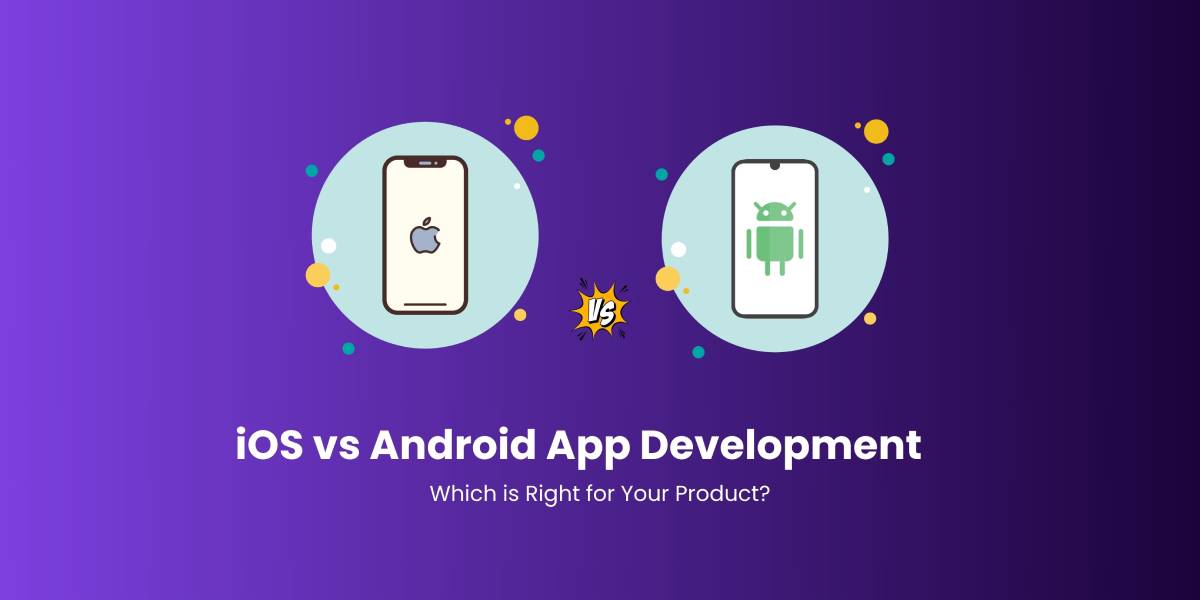Choosing between iOS and Android app development is one of the first and most important decisions in creating mobile apps. Both platforms dominate the mobile world, but they differ significantly in user demographics, design principles, development processes, and cost.
If you want your product to succeed, understanding these differences will help you select the right platform aligned with your goals, budget, and target audience.
In this blog, we’ll explore the key differences between iOS development and Android app development, the pros and cons of each, cost considerations, and tips to help you decide which platform fits your product best.
Market Overview: iOS vs Android
Android Market Share
Android is the world’s most popular mobile OS, powering over 70% of global smartphones. Its open ecosystem attracts diverse manufacturers and reaches users across emerging and developed markets.
iOS Market Share
Apple’s iOS runs on fewer devices—mainly iPhones and iPads—but boasts high user engagement and spending power. iOS users dominate in North America, Western Europe, and affluent urban areas worldwide.
What This Means for You
If your product targets a global audience, especially in price-sensitive markets, Android might be the better start. For premium products focused on quality and monetization, iOS development could yield higher ROI.
Development Environment and Languages
Android Development
- Uses Java and Kotlin as primary programming languages
- Development is done via Android Studio, a powerful IDE with robust debugging and testing tools
- Open-source with a vast library ecosystem and hardware diversity
iOS Development
- Uses Swift (modern, fast) and Objective-C (legacy)
- Developed with Xcode, Apple’s official IDE, optimized for iOS devices
- Closed ecosystem with strict app store guidelines and tighter hardware control
Impact on Development
- Android’s diversity means you need to test across many devices and OS versions
- iOS development has fewer devices to test, enabling faster QA cycles
- Learning curve varies depending on your team’s expertise with Java/Kotlin vs Swift
Design Differences: Android Design vs iOS Design
Android Design
Android apps follow Material Design principles emphasizing bold colors, flexible layouts, and depth effects like shadows. Android favors customization, widgets, and diverse screen sizes.
iOS Design
iOS apps follow Apple’s Human Interface Guidelines, emphasizing clarity, depth, and intuitive navigation with minimalistic aesthetics. iOS favors smooth transitions and consistency across devices.
User Experience Impact
Choosing platform-specific design ensures the app feels native to users. Hybrid or cross-platform apps can sometimes feel “off” if they don’t follow these distinct design systems.
Performance and Hardware Considerations
Android Devices
Wide range of devices from budget to premium, varying in CPU power, screen resolution, and sensors. Your app must be optimized for fragmentation, which can affect performance.
iOS Devices
Apple’s devices are more uniform, allowing apps to leverage hardware capabilities efficiently, resulting in smoother performance and better graphics handling.
Monetization and Revenue Models
iOS Users
Tend to spend more on apps and in-app purchases. If monetization is a key priority, iOS app development can be more lucrative.
Android Users
Larger user base but generally lower spending per user. Android is ideal for ad-supported models or volume-based services.
Cost of Creating Mobile Apps on iOS vs Android
Factors Influencing Cost
- Development complexity
- Number of features
- Platform-specific UI/UX design
- Testing and maintenance
iOS Development Cost
- Often higher hourly rates due to specialized Swift developers
- Lower device fragmentation reduces QA effort
- Streamlined app submission process but strict review guidelines
Android Development Cost
- Wide device range means more testing time
- Larger developer pool may reduce hourly costs
- Open app store with faster approval but potential security risks
💰 On average, iOS apps cost between $40,000 – $150,000 to develop; Android apps vary from $30,000 – $140,000 depending on complexity.
Time to Market
- iOS apps typically have faster development and testing cycles due to fewer devices and controlled ecosystem
- Android apps take longer to optimize for diverse devices and OS versions
- Submission and approval can be faster on Android but less predictable due to fewer controls
Security and Privacy
- iOS is generally considered more secure due to Apple’s strict control over hardware, OS updates, and App Store review
- Android offers more flexibility but has a higher risk of malware due to third-party app stores and OS fragmentation
- Both platforms offer APIs and tools to build secure apps—your implementation is key
User Demographics and Geography
- iOS dominates in markets like the USA, Canada, Australia, Western Europe
- Android leads in Asia, Africa, South America, and lower-income segments
- Consider where your target users are and which platform they prefer before deciding
Cross-Platform Development: A Middle Ground?
Many startups choose cross-platform development frameworks like Flutter or React Native to build for both iOS and Android simultaneously.
Pros:
- Reduced development time and cost
- Single codebase for both platforms
- Easier maintenance and updates
Cons:
- May compromise on native UX and performance
- Platform-specific features harder to implement
- Larger app size and potential bugs
Cross-platform can be a great start, but for complex or performance-critical apps, native development still leads.
Which Platform Should You Choose for Your Product?
| Product Type | Best Platform | Reasoning |
| Consumer-focused apps | iOS | Higher monetization, premium audience |
| Mass market apps | Android | Larger user base, emerging markets |
| Enterprise apps | Depends on user base | Match platform to internal device use |
| MVP or early-stage | Cross-platform (Flutter, React Native) | Cost and speed advantages |
| Performance-heavy apps | Native (iOS/Android) | Better performance and native integration |
Final Thoughts
Choosing between Android app development and iOS app development boils down to your product goals, target audience, budget, and timeline. Both platforms have unique strengths and challenges.
For startups and businesses aiming to maximize reach and ROI, many begin with cross-platform MVPs and later optimize native apps based on analytics and user feedback.
Whichever path you choose, partnering with an experienced and affordable mobile app development team will help you navigate complexities and deliver a product your users love.



